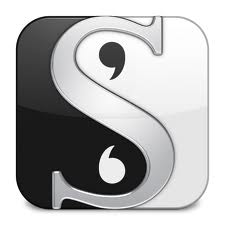by Mary Sutton / @mary_sutton73
 Note: I am using Scrivener for Mac. If you are using Windows, allow for differences.
Note: I am using Scrivener for Mac. If you are using Windows, allow for differences.
I finished the tutorial. I created a project, and set up my character and location sheets. Now I’m ready to write.
At the heart of Scrivener, at least the fiction projects, are Chapters and Text documents. Chapter documents can contain text or just be a “holder” for Text documents, which are usually scenes. In this way, Scrivener forces you to write scene-by-scene.
At first I didn’t think I was going to like this. After all, when I get in a groove, I don’t want to stop. On second thought, and after using Scrivener to prepare sample scenes for a project, I like it.
The reason? Simple. The mantra in writing is that every scene needs to move the story forward. Every scene needs to contain some conflict, or tension. If you don’t consciously write scene-by-scene, it’s easy to lose sight of this. So now when I sit down, I can focus on one particular scene. For example, “here’s the scene where she meets the man who is going to be her mentor.” And all of my thoughts focus on that scene, instead of wandering off into something three chapters later.
This scene-by-scene structure will pay off later as well. I’ve often had to restructure works and had to hunt for the scenes. I’m sure you know the feeling. “I need to move that love scene in the hot tub. Now was that chapter 7 or chapter 9?” If you’re writing by scene, you can zero in on that love scene and drag it to the new location.
This is probably why Scrivener recommends not using “Scene 1, Scene 2,” etc. Give your scenes meaningful descriptions. I also used the Synopsis note functionality. That way I know “Love scene in the hot tub” is actually the scene I’m looking for – and that’s pretty cool. The ability to drag a scene is also much easier than the old “cut big chunk of text, paste to second document, find new location, cut text again, paste to new location” work flow in Microsoft Word. I mean, that might not be bad for a 5,000 word short story, but for a 90,000 word novel it’s exhausting.
The actual typing in Scrivener is rather like any word processing program, so there’s not much to say. It’s got a default font and single paragraph spacing. You can change that if you want because it’ll all be standardized when you compile your project (that’s the term Scrivener uses for creating the final manuscript).
Because people have asked about learning curve, I’ll say that I think it’s not very steep, especially if you are starting a new project (like I am). I’m sure there’s more to learn if you import an existing project (written in Word or something else) and they’ll be some to learn upon compilation. But I think anyone can get the basic content-creation work flow down in a few hours to a couple of days.
I’m going to get writing now. If I learn anything stupendous, I’ll blog again, but expect my next Scrivener blog entry to be about compilation. That will take a few days.
Updated 6/16/12: I forgot about one really cool thing. You can assign a status to each scene: First Draft, To Do, Finished, etc. This way you can see how much needs to be done. Also, if you’re further down the story, and you suddenly think, “Oh man, I need a love scene in the hot tub in Chapter 3,” you can put the text document for the scene where you need it, leave it with a status of “To Do,” and keep on motoring where you are, so you don’t break the creative groove you’re in. I like that – better than a post-it note. =)
